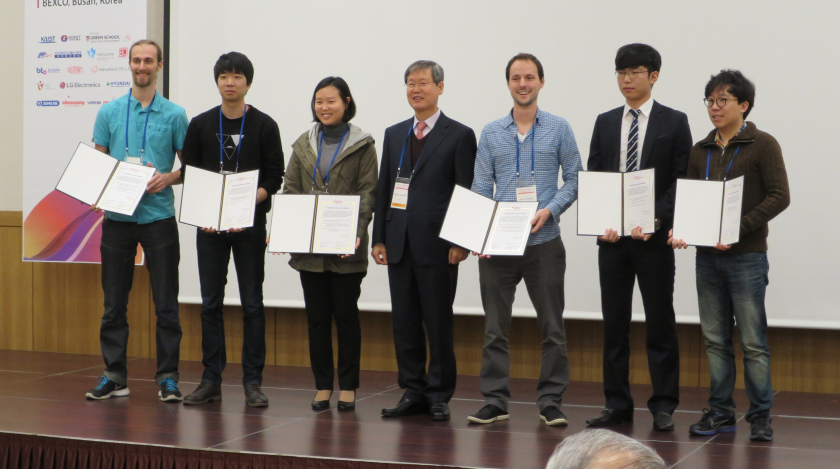PVcomB-25 paper awards for two HZB-Contributions

On stage for the PVSEC-25 Paper Awards. Jan-Peter Bäcker (1. on left side) and Marc Daniel Heinemann (5. on left side).
At the 25th International Photovoltaic Science & Engineering Conference (PVSEC) two papers from the HZB-Institute PVcomB have been awarded: Jan-Peter Bäcker and Marc Daniel Heinemann received the PVSEC-25 Paper Award for their research on chalcogenide solar cells (CIGS). The PVSEC was held from 15. to 20. November in Busan, Korea.
Jan-Peter Bäcker and his co-authors presented their research on phase separation in Copper-Indium-Gallium precursor thin films for sequentially processed Cu(In,Ga)Se2 solar cells". Marc Daniel Heinemann and his co-authors reported on results on CIGS solarcells in „superstrate“-configurations.
You can find more informationen and the abstracts of the awarded papers at the PVcomB-newspage here:
"Phase separation and coarsening in Cu-In-Ga precursor thin films for sequentially processed Cu(In,Ga)Se2 solar cells"
J.P. Bäcker, S.S. Schmidt, M. Hartig, C.A. Kaufmann, R. Mainz, H. Rodriguez-Alvarez, C. Wolf, R. Schlatmann
"Revival of CIGSe Superstrate Solar Cells?"
M.D. Heinemann, J. Berry, D. Greiner, M. Wollgarten, T. Unold, R. Klenk, H.-W. Schock, D. Ginley, R. Schlatmann, C. A. Kaufmann
red.
https://www.helmholtz-berlin.de/pubbin/news_seite?nid=14371;sprache=en
- Copy link
-
Bright prospects for tin perovskite solar cells
Perovskite solar cells are widely regarded as the next generation photovoltaic technology. However, they are not yet stable enough in the long term for widespread commercial use. One reason for this is migrating ions, which cause degradation of the semiconducting material over time. A team from HZB and the University of Potsdam has now investigated the ion density in four different, widely used perovskite compounds and discovered significant differences. Tin perovskite semiconductors produced with an alternative solvent had a particular low ion density — only one tenth that of lead perovskite semiconductors. This suggests that tin-based perovskites could be used to make solar cells that are not only really environmentally friendly but also very stable.
-
Joint Kyiv Energy and Climate Lab goes live
Helmholtz-Zentrum Berlin and the National University of Kyiv-Mohyla Academy established on 27 November a Joint Energy and Climate Lab.
-
Helmholtz Investigator Group on magnons
Dr Hebatalla Elnaggar is setting up a new Helmholtz Investigator Group at HZB. At BESSY II, the materials scientist will investigate so-called magnons in magnetic perovskite thin films. The aim is to lay the foundations for future terahertz magnon technology: magnonic devices operating in the terahertz range could process data using a fraction of the energy required by the most advanced semiconductor devices, and at speeds up to a thousand times faster.
